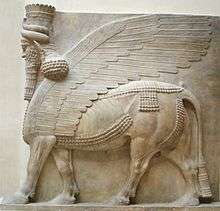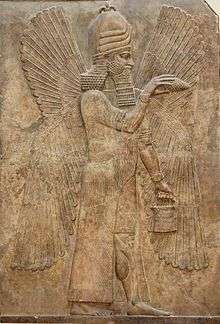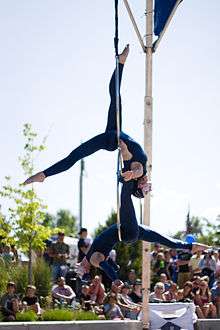Wikijunior:Ancient Civilizations/Assyrians
< Wikijunior:Ancient CivilizationsWhat country did they live in?
Assyrians lived in northern Mesopotamia from 1900 – 612 BC. During the height of its power (8th – 6th centuries BC), it expanded to cover the whole of Mesopotamia (including Babylon, Syria, Palestine and Cyprus) as well as northern Arabia and north-eastern Egypt.
The History of Assyria
The history of the Assyrian Empire can be divided into three segments (or parts), the Old Assyrian Empire, the Middle Assyrian Empire, and the New Assyrian Empire. The Old Assyrian Empire was formed around 1900 B.C. and lasted until around 1363B.C.
The Old Assyrian Empire was a time of conquest. The Assyrians attacked their neighbors, such as Sumer and Akkad, and grew more powerful, though still not as powerful as some of their other neighbors.
During Middle Assyrian Empire,the Empire was very powerful and still growing. This stage in the life of the empire lasted from 4000 - 1000 B.C.
The New Assyrian Empire occurred during the pinnacle (or top) of the empire's power. The Assyrians owned most of their known world. In fact, the kings thought that the gods chose them to rule, and that made them representatives of the gods on earth. This was a form of what is known as Theocracy. Theocracy is a form of Government where ruler's power comes from religion. The kings were given titles and names like, "King of the Universe." Because of their power they were not only in charge of the army but the temples too. During this time magnificent palaces and temples were constructed, partly to show off the wealth (or money) of the kings. The last great king during the was Ashurbanipal (pronounced Ash-er-ban-ee-pol). He ruled from 668-627 B.C. After his rule the country soon fell. The Medes and Babylonians invaded and finally defeated the nation in 612 B.C.
What did their buildings look like?

Assyrians built magnificent temples and palaces, decorated with beautiful reliefs and statues of winged bulls, known as cherubs (though you must be careful not to confuse these with angels of the same name).
What did they eat?
Assyrians ate a platter of ground lamb, wheat, pine nuts, and other middle eastern spices. This was called Kidbei (Kid-be). Their bread was called lehmo or pita. Yogurt was a main part of the Assyrians diet. Assyrians had two main desserts one is a pastry filled with a buttery paste. This is called Kadee. The other dessert is called Baklava. Baklava is a dessert found in many other middle eastern civilizations. Richta, an Assyrian rice dish is tasty. Booshala is a creamy soup with many delicious ingredients one of which is ground lamb.
What did they wear?

The men wore long coatlike garments and were bearded. Women wore a sleeved tunic and a shawl over their shoulders. Knee-length and full-length tunics (a garment like a shirt) with short sleeves were the most common types of clothing worn. They were worn along with some type headdress. Shawls were also worn. The two were generally worn together, but sometimes not.
Though there are no actual pieces of clothing around today, archeologists can still infer with some help from the Old Testament of the Bible that rich coloring was prominent. Colors probably included:
- Blue: dark indigo, though sometimes lighter.
- Red: A lot Indian red.
- Yellow
- Green
- Purple: Dark, and a little brownish.
What did their writing look like?
Assyrian writing was called cuneiform (kU-nee-u-form).The cuneiform is one of the oldest known forms of writing. Cuneiform writing began as a system of pictographs. Over time, however, its letters simplified and became less of a picture.
Cuneiform was written upon clay tablets, on which symbols were drawn with a blunt reed called a stylus. The indentations left by the stylus were wedge shaped, which gave rise to its name, cuneiform ("wedge shaped").
What did they believe?

Babylonian and Assyrian religion had much in common: most of the myths and the gods were the same. One difference though was that in Assyria the king of gods was Assur, the patron god of the city of Assur, unlike Babylonian Marduk, the patron of Babylon.
The following is a list of gods worshipped by the Assyrians:
- Ishtar, the goddess of love
- Adramelech, A sun god
- Anshar, the national God
- As Shalla, the Assyrian goddess of grain
- Anasas, God of medicine
- Nishraeli
- Nisroch, god of farming
- Nimrod
- Oannes
- Nabu, god of Wisdom and Writing
- Samnuha
- Gubaba
- Ashur/Assur, king of the gods
Are some of them famous even today?
King Ashurbanipal is known for his library of cuneiform tablets. It was the largest collection of the books in the ancient world. Many masterpieces of ancient literature and many facts from ancient history are known to us from the documents of Ashurbanipal’s library. Also, the Assyrians are mentioned in the Bible as the people who conquered Israel over a hundred years before Judah's conquest. We can also see, in the Bible, that the Assyrians were conquered by the Babylonians, who conquered Judah later on.
What is left of them today?
Assyrian people still live in northern Iraq, Iran, Syria, Palestine (specially Jerusalem) Jordan (Medaba), Australia, and the US. They speak Aramaic language and most of them are Christians.